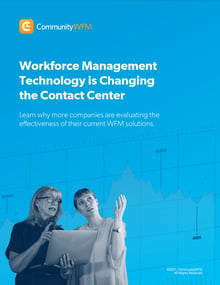
The way companies communicate with customers will always evolve. A hundred years ago, traditional phone support didn’t even exist. People had to physically visit stores to ask questions about products, receive store credit, and more. Now, a customer can choose one of many ways to contact a company from anywhere and receive an immediate refund directly to their bank account.
The most recent innovation for customer communication – live chat – is starting to become less of a “nice to have” for contact centers and more of a mandatory channel. Just another phase of industry evolution!
All of this leads to one question… what’s next? There may not be a clear answer yet. However, the technology many contact centers continue to monitor as its momentum pushes forward is asynchronous messaging communication. Read on to learn more about this new channel and its future impact on contact centers.
WHAT IS ASYNCHRONOUS MESSAGING COMMUNICATION?
Asynchronous messaging is like email because it’s a longer form customer conversation which doesn’t happen in real-time. The history of every message is logged within a technology platform, such as WhatsApp, and can be referenced by both parties to help communicate and resolve an issue.
THE POSITIVES OF ASYNCHRONOUS MESSAGING
Not every single issue that reaches a contact center is urgent. Asynchronous messaging enables customers to utilize the device they use most – their smartphone – with an app they may use frequently to start a support conversation that happens on their terms. They can start a dialogue by sending an in-app message during their lunch hour, follow up with details on their 3PM break, and have a solution to their problem waiting for them when they get off work. The customer doesn’t have to make a phone call and wait on hold, and the contact center doesn’t need worry about messages getting trapped or lost in spam filters and folders (a major and growing problem with email communication).
THE NEGATIVES OF ASYNCHRONOUS MESSAGING
Staffing agents to work with asynchronous messaging apps is not always as straightforward as phone or chat. Forecasting an accurate number of phone agents with workforce management (WFM) software is typically a simple process because you can track conversation lengths and volume to determine how many agents you will need. Building an accurate forecasting model for asynchronous messaging is more difficult because they don’t have a defined beginning and ending. Given that messages can be exchanged seemingly forever, some conversations can last weeks or even months. The duration of each conversation is challenging to predict. And, just like email, jumping between so many conversations can lead to agent confusion and stress.
THE FUTURE OF THIS COMMUNICATION STYLE FOR CONTACT CENTERS
When it comes to a contact center, the driving force behind a conversation is the customer. Their communication journey has led contact centers from phone to email and then to chat. Next up appears to be asynchronous messaging. The driving force behind previous channel movement has been contact centers attempting to meet customers where and how they want to have conversations. 20 years ago, customer support chat was the response to AOL Instant Messenger. Now, contact centers have taken the conversation a step further by meeting a customer directly within WhatsApp.
From an operation perspective, asynchronous messaging isn’t all that different than email. Many of the popular messaging apps have desktop versions for agents to use more efficiently. The most important thing to plan for is the shift in how customers communicate with your contact center. If you aren’t already, keep a close eye on channel volume in relation to the total number of contacts you receive per week or month. Every business is different, but with younger generations in general preferring to avoid phone calls, the rise of asynchronous messaging makes sense in theory.
To summarize, the concept and capabilities of asynchronous messaging communication may lead it to be the next major addition within the sphere of contact center channels. With this said, it’s important to weigh both the pros and cons of the channel to determine if it’s a good fit for your unique situation. The contact center industry has a reputation for moving slowly, so prioritize caution over speed when it comes to adding asynchronous messaging to your technology stack. Like other channels in the past, it has been slowly continuing its rise in popularity, but its emergence won’t happen overnight.








